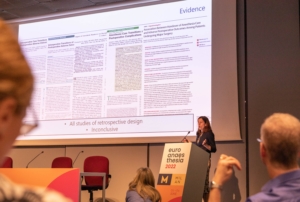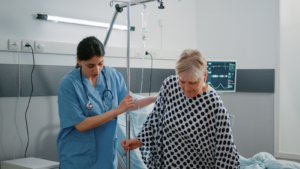Congress Newsletter 2022
Live Report from Saturday – the impact of the anaesthesia handover on morbidity and mortality
Session 14L1 – took place during Saturday, 1515-1600H, Red Room 2
This session can be watched on-demand on the Euroanaesthesia platform

In a fascinating session during yesterday afternoon, Professor Melanie Meersch-Dini (University Hospital Münster, Germany) not only reviewed the existing evidence but also presented her team’s own results from their new study – the HandiCAP trial, which was published as she was speaking in the Journal of the American Medical Association (JAMA) (see link below).
Prof Meersch-Dini went through a number of previous studies, which have provided conflicting results on this issue – some showing no statistically significant effect of the handover on mortality, while others showed an increased risk of death associated with more handovers. Since these were all retrospective studies, there are issues interpreting these results.
However, this new study by Meersch-Dini and colleagues is the first to address the effect of intraoperative handovers of anaesthesia care on mortality, readmission, or postoperative complications among adults using a randomised clinical trial.
This was a parallel-group, randomised clinical trial conducted in 12 German centres with patients enrolled between June 2019 and June 2021 (final follow-up, July 31, 2021). Eligible participants had an American Society of Anesthesiologists physical status 3 or 4 and were scheduled for major inpatient surgery expected to last at least 2 hours. A total of 1817 participants were randomised to receive either a complete handover to receive anaesthesia care by another clinician (n = 908) or no handover of anaesthesia care (n = 909). None of the participating institutions used a standardised handover protocol.
In this randomised clinical trial that included 1772 patients, the composite primary outcome of mortality, readmission, or serious postoperative complications within 30 days did not differ significantly among participants randomized to receive handover of anaesthesia care vs no handover of care (30% vs 33%, respectively).
Prof Meersch-Dini concluded: “Among adults undergoing extended surgical procedures, there was no significant difference between handover of anaesthesia care compared with no handover of care in the risk of postoperative morbidity and mortality.”
Among the questions after the talk, one delegate asked how such a study could be blinded, and Prof Meersch-Dini explained while the anaesthesiologist in the room did not know whether or not the patient they were treating was part of the study, the attending (or ‘supervising’) anaesthesiologist needed to know to deal with the administration of randomisation. Other questions examined the huge range of variables at play in a handover and the intrinsic difficulties in proving cause and effect. She also explained that many questions remain open, including the influence of the expertise of the surgeon on the results.
Chair Dr Jannicke Mellin-Olsen (Norway) concluded the session by saying she hoped that the new study had alerted all delegates to the importance of giving time and attention to the handovers that they perform.
For full article published in JAMA, click here
Read More of our special newsletter covering our congress.










